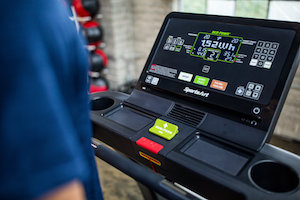By Ivo Grossi, CEO of the Americas for SportsArt
Many of our daily activities – such as using electricity, driving a car, or using home appliances – cause greenhouse gas emissions that drastically increase our individual carbon footprints. In fact, the United States Environmental Protection Agency (EPA) calculated that in 2014, greenhouse gas emissions totaled 6,870 million metric tons (15.1 trillion pounds) of carbon dioxide equivalents in the U.S. alone. This same report determined that among the various sectors of the U.S. economy, electricity generation accounts for the largest share of emissions – 31 percent of total greenhouse gas emissions since 1990. Transportation is the second-largest sector, accounting for 26 percent of emissions since 1990.
There are several daily activities that most Americans participate in that are feeding into our emissions problem: working out, driving, and household living. Below are ways that individuals can help offset their emissions, and in some cases even produce energy as a way to reduce their own carbon footprint and better our planet.

Working Out
According to Live Science, running on a treadmill for 30 minutes, three times a week, will boost your gas emissions by 0.07 metric tons per year (154 pounds). While running outside is a great way to reduce one’s carbon footprint to zero, there is fitness equipment which allows users to actually produce energy as they workout. Within these machines are micro-inverters similar to those used in solar panels and wind turbines. The inverter allows the machines to harness up to 74 percent of the user’s power, and feeds it back to the facility’s electrical grid to help power lights, laptops, etc. This type of innovative technology goes one step further by not only reducing energy consumption, but actually providing a new source of energy.
Driving
The EPA’s recent green vehicle guide estimates that a typical passenger vehicle emits about 4.6 metric tons of carbon dioxide per year – though this number can vary based on a vehicle’s fuel, fuel economy, and the number of miles driven per year. Carpooling is one great option, but the most effective way to reduce your driving emission is to purchase a green car.
Tesla is one of the most widely known brands of electric cars due to its pioneering in the space and sleek designs. Since all Tesla cars are electric, the company still dominates as one of the leaders in the energy efficient automobile space; however, many other brands are beginning to offer a line of green cars. For example, the American Council for an Energy-Efficient Economy (ACEEE) gave out the highest Green Score of 70 to the Hyundai Ioniq Electric with an EV range of 124 miles. Technology has helped in advancing electric cars throughout the years, creating higher green scores and lowering costs to make electric cars affordable for all.
Related: Elon Musk Challenges Car Companies to Go Electric
Home Living: Heating and Lighting
Your home sucks up a lot of energy, mainly stemming from heating and lighting. There are various causes of energy waste from heating, such as poor insulation or outdated thermostats, which are not programmable. To combat this, you can draught-proof the house as a way to better insulate it, as well as install eco-thermostats. There are several brands of thermostats that now have smart/auto programming, airwaves, and provide home energy reports that calculate when you use the most energy and provide suggestions on how to limit your heating.
While traditional LED lights are a great source of energy reduction, they are still standard lights that require an on and off switch. To truly go eco-friendly with your lighting, invest in smart lightbulbs which allow you to turn off lights through voice activation and phone apps. This ensures users they are never wasting electricity by accidently keeping lights on.
While everyday activities may seem harmless, there are small changes we can make to reduce our carbon footprint. With continuous efforts in the sustainability field, these same products are constantly being upgraded to reduce more energy and become even more affordable. If more companies and individuals do their part by practicing these sustainable efforts, we can drastically reduce the harmful emission that America is known to produce.
To calculate what your carbon footprint is, go to: https://www3.epa.gov/carbon-footprint-calculator/.









